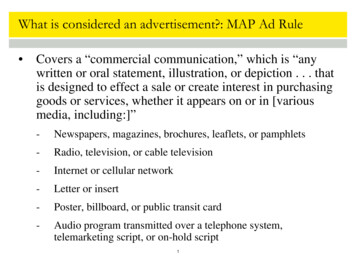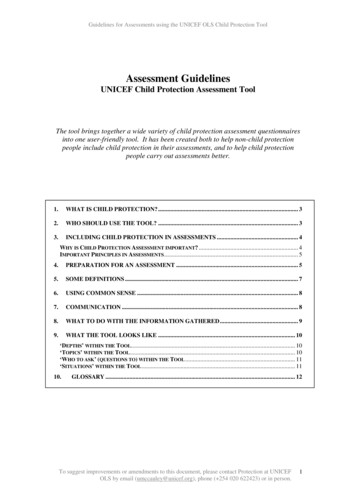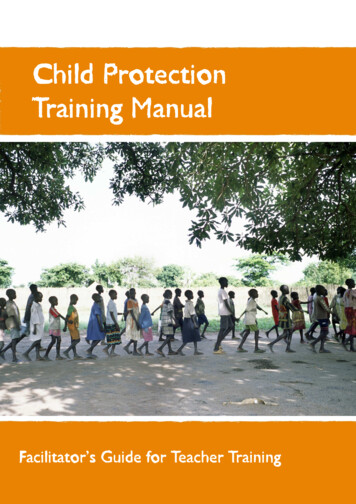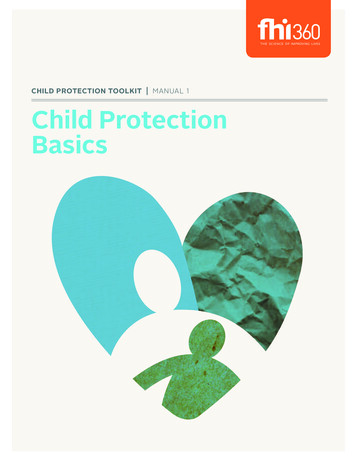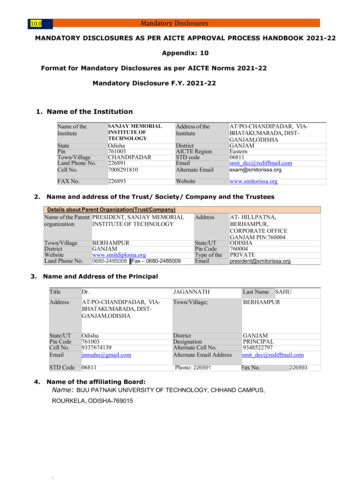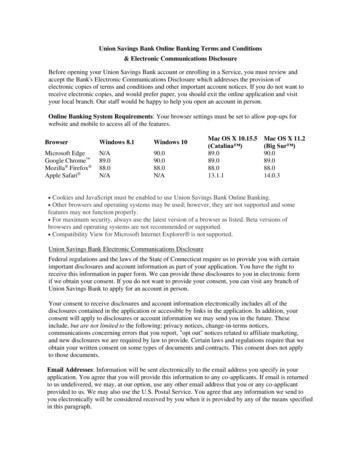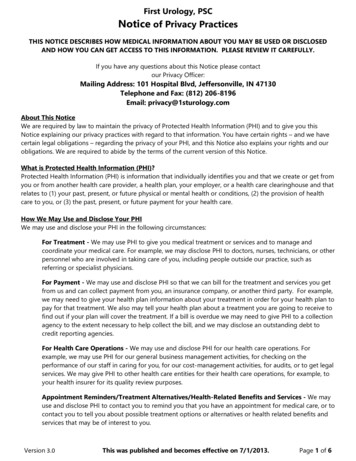
Transcription
Education Safeguarding Team (June 2015)Child Protection - Dealing with disclosures in schoolChildren experiencing distress or abuse may seek to ‘tell’ in school, often because this isthe place where they feel most safe, secure and listened to. It is not unusual for them tochoose members of staff seen to be on the periphery of the staff team such as middaysupervisors, caretakers or class-room support staff because they may be perceived ashaving less authority and less intimidating. It is important to make sure therefore thatALL staff know how to respond to a disclosure from a child.If a child discloses harm to any staff member it must be remembered that the school roleis to recognise and refer abuse, not to investigate. This is to avoid contamination ofevidence gained in any subsequent investigation undertaken by Police &/or SocialServices and to ensure that the child is not placed in the stressful position of having torepeat their story over and over again.‘Not investigating’ does not mean that the staff member receiving the concern cannotask any questions. However, careful thought needs to be given to how and whatquestions are asked, avoiding anything that can be interpreted as ‘leading’ the child. Thebasic rule of thumb is that staff should ONLY ask enough questions of the child to clarifywhether there is a child protection concern. Once the child has clarified that they arebeing harmed or are at risk (or the staff member is reassured that the child is safe), nofurther questions are required.If a child presents with an injury accompanied by a clear disclosure that they have beenharmed, or makes a clear sexual disclosure it should not be necessary to question thechild other than perhaps to clarify who was involved and when an incident took place.The child should be listened to actively and their story carefully recorded. In this situationthe staff member should ensure immediate information sharing with the DesignatedSafeguarding Lead (or alternative senior contact point in DSL’s absence). It is likely thatsuch a scenario will require immediate consultation about action to be taken and anurgent referral to Specialist Children’s Services will be necessary.In other situations where the child appears to be making a possible disclosure or has asuspicious injury, it is reasonable to ask open, non-leading questions in order toestablish the child’s story. Examples of questions are. “That’s a nasty bruise, how did ithappen?; Tell me about what happened?; You seem a bit upset and I’m worried aboutyou, is anything troubling you?; Can you tell me more about that?”You may wish to use the acronym ‘TED’ as a reminder that the child can be encouragedto ‘Tell’, ‘Explain’ and ‘Describe’ the concern. If it is necessary to seek further1
clarification, staff should keep to open questions such as What? When? Who? How?Where? It is important to remember that questions should only be asked to help clarifywhether the child is at risk of harm. Once clarification is achieved, no further questionsshould be asked.Sometimes children choose to disclose concerns through a third party such as a friend‘telling’ on their behalf, or indirectly e.g. sounding out information and reaction by asking‘what if my friend .?’ If such concerns arise they should be taken equally seriouslyand be followed up with the DSL in the same manner as a direct disclosure.Children may also seek to disclose and share their experiences through drawings,writing and play. If concerns arise, it is appropriate to talk further with the child to allowwider discussion and clarification. This might involve inviting the child to ‘tell me moreabout what is happening in your picture’ / story / game”If a child discloses abuse, this information requires immediate sharing with theschool’s Designated Safeguarding Lead.Basic guidelines for dealing with disclosures1. Remember that the child’s welfare and interests must be the paramount considerationat all times.2. Listen carefully and actively to the child. At this stage there is no necessity to askquestions. Let the child guide the pace.3. Do not show shock at what you are hearing. This may discourage the child fromcontinuing their disclosure as they will feel that the adult receiving the information isunable to cope with what they are hearing and may be thinking badly of the child.4. Do not investigate. If you need to clarify what is being said and whether the child isat risk, ask open questions (TED, what, when, who, how, where, do you want to tellme anything else? etc.) but only to the point of clarification being achieved. Avoid thequestion ‘why?’ as this can imply guilt / responsibility on the child.5. Stay calm and reassure the child that they have done the right thing in talking to you.6. Never promise to keep a secret or confidentiality. You have a duty to ensure theinformation is passed on to DCPC and possibly other agencies in order to keep the childsafe. If a child requests confidentiality, use a ‘prepared’ response, such as ‘I’m reallyconcerned about what you have told me and I have a responsibility to help ensure thatyou are safe. To help make sure you are safe, I have to tell someone (name person)who will know how to help us to do this’. Make sure the child understands what willhappen next with their information.7. Record factually what the child has told you or what you have observed as soon aspossible. Ensure records include the date, time, place of disclosure, behaviour andwords used by the child. Failure to accurately record information or writing down your‘interpretation’ of the child’s account may lead to inadmissible evidence.2
8. If you have seen bruising or an injury, use a body map to record details. Againensure that the map is dated and attached to information relating to the child’scomments about the injury.9. Tell your DCPC as soon as possible but do not ask the child to repeat what theyhave told you to another staff member. This is stressful for the child. The more times achild is asked to tell their story the greater the chance of the facts becoming lost and anysubsequent investigation being compromised.10. Do not gossip to other staff about what you have heard. The information shouldremain confidential to those who ‘need to know’.11. Maintain contact with the child. They have trusted you enough to ‘tell’, will need toknow that they are not rejected as a result and may need continued support.12. Ensure that you have support for yourself in managing the information you havereceived.NOTE: Disclosures relating to allegations against colleagues and members ofstaff should be treated in the same way. This information must be passedimmediately to the Head Teacher or DSL who will contact the LADO and ensurethe appropriate procedures are followed.Basic guidelines for dealing with disclosuresWhen a child discloses abuse:1.2.3.4.5.6.7.8.Stay calm and listenGo slowlyReassure them that they have not done anything wrongBe supportiveGather essential factsTell what will happen nextReportMake notes1. Stay calm An abused or neglected child or young person needs to know that you areavailable to help them.Reactions of shock, outrage, or fear might make them feel more anxious orashamed.A calm response reassures that what has happened is not so bad and can beworked through.2. Go slowlyIt is normal to feel inadequate or unsure about what to do or say when a child oryoung person tells you about their abuse.3
Proceed slowly.Gentle and open-ended questions such as: "Can you tell me more about whathappened?" are helpful.Avoid questions that begin with "why".3. Be reassuring Reassure the child or young person that they have not done anything wrong.Avoid questions that are usually associated with getting into trouble. Avoidusing "why" questions.4. Be supportiveLet the child or young person know: they are not in troublethey are safe with youyou are glad that they have chosen to tell you about thisthey have done the right thing telling about thisyou are sorry that they have been hurt or that this has happened to themyou will do everything you can to make sure they are not hurt againyou know others who can be trusted to help solve this problem5. Get only the essential facts Be brief.Limit your discussion to finding out generally what took place.When you have sufficient information and reason to believe that abuse and/orneglect has occurred, gently stop gathering facts and be supportive.6. Tell what will happen next Don't make promises to the child about what may or may not happen next.Provide only reassurance that is realistic and achievable.Discuss with the child what you think will happen next and who will beinvolved.7. Report to the Designated child protection coordinator Report disclosures of abuse or neglect immediately to the DCPC for follow-upand referral.Express your willingness to help the child through the steps which will follow,if appropriate.8. Make notes Make notes of all comments. Use the child's or young person’s exact wordswhere possible.Save all drawings and artwork. This information may needs to be shared withChildren’s Social Services and the police.4
NOTE: Disclosures relating to allegations against colleagues and members ofstaff should be treated in the same way. This information must be passedimmediately to the Head Teacher or DSL who will ensure the appropriateprocedures are followed5
5. Stay calm and reassure the child that they have done the right thing in talking to you. 6. Never promise to keep a secret or confidentiality. You have a duty to ensure the information is passed on to DCPC and possibly other agencies in order to keep the child safe. If a child requests confidentiality, use a 'prepared' response, such as .
